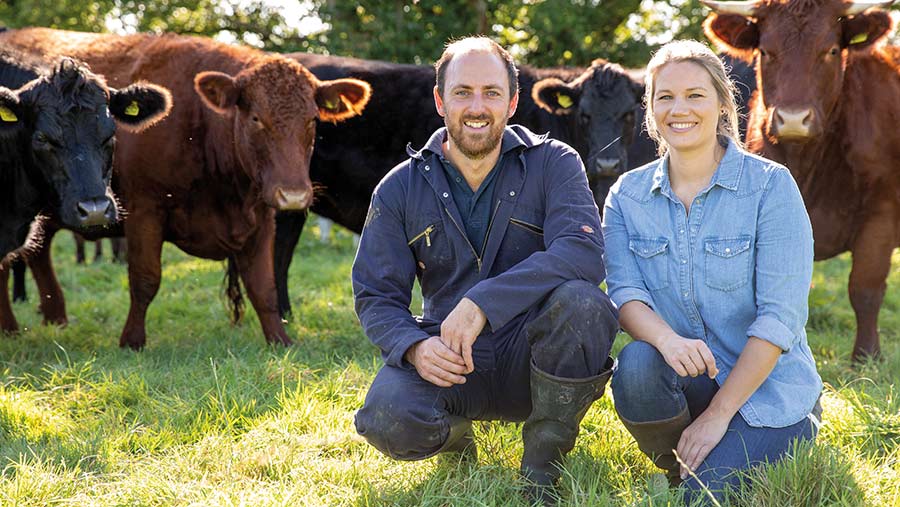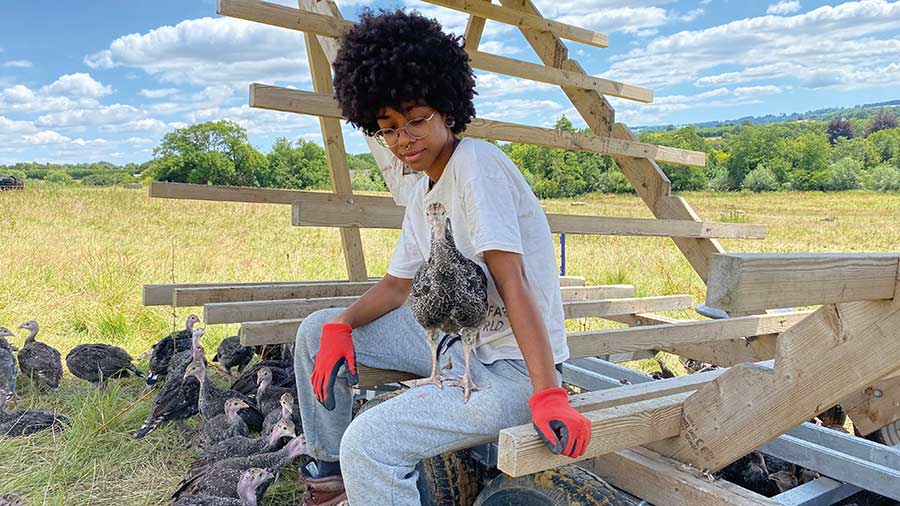How Somerset farmer uses enterprise stacking to maximise output
 Ollie White and Charlotte Christensen © Ollie White/Farm2Fork
Ollie White and Charlotte Christensen © Ollie White/Farm2Fork Somerset farmer Ollie White has developed a low-cost, environmentally focused model of stacking livestock enterprises on his 50ha (124-acre) county council tenanted farm to maximise the value of his overall output.
Mr White took on the former dairy farm near Ilminster nine years ago. He started with beef and sheep, supplemented with geese for the Christmas market.
These were followed by turkeys and broiler chickens, all rotationally grazed and moved daily on permanent pasture.
See also: What is holistic grazing and what are the benefits?
Farm facts: Greenway Farm, Ilminster, Somerset
- 50ha (125-acre) mixed farm on county council tenancy
- Registered organic with Organic Farmers and Growers and A Greener World
- 60 Angus-cross cattle bought in as stores in spring and autumn to finish on farm
- 115 breeding New Zealand Romney ewes (finishing 150 lambs)
- Three batches of 1,300 Hubbard-787 broiler chickens; 400 geese (German breed, unknown); 200 Kelly’s turkeys
- Selling all stock direct through online sales (farm2fork.co.uk) and a farm shop
He raises stock to finishing weights and uses a local abattoir and butchery before packing and distributing meat products direct from the farm.
He sells all his stock direct to the consumer, having decided to follow a retail model rather than commodity sales.
What is enterprise stacking?
Enterprise stacking is designed to maximise output by running several enterprises alongside each other. For Mr White, it also means ensuring these enterprises work together in symbiosis.
His organic, grass-fed system, with cattle, sheep and poultry grazing the same land consecutively, can increase efficiency of pasture use and reduce parasitic burden, he says.
This is because of the different grazing strategies and preferences of the animals. A more efficient pasture enables a longer rotation and therefore better feed efficiency.

© Ollie White/Farm2Fork
Year-round grazing
Central to his farming system is ensuring the pasture can be used by livestock throughout the year, with minimal external inputs.
He does this by following the Allan Savory holistic grazing model, whereby pastures are allowed to fully recover before animals return to graze again.
Last summer, the pastures had a 90-day recovery period. In the autumn, that shortened to 60 days. Now, during winter, it is raised to 120 days with bale grazing.
“The whole premise of holistic management is one of putting the pasture foremost in your decision-making,” he explains.
Mr White’s focus on pasture is also central to his animal health management. When he experiences a problem, he searches for the root cause.
He used this approach to reduce the incidence of infectious bovine keratoconjunctivitis (IBK), or pink eye, in his cattle.
“I used to put herbal leys in, and we were allowing our chicory to grow really tall. But the cows were getting pink eye because they were scratching their eyes on the seeds.”
Once he realised what was causing the issue, he decided not to use herbal leys again and moved to permanent pasture.
Since taking on the farm tenancy, soil health has improved.
‘’When we tested [our soil] last summer, I was pleased to see that across the board we had increased soil organic matter by more than 1%. And all indices had improved [since the first year of the tenancy].
“That’s without us putting any inputs down, other than bought-in hay.”

© Ollie White/Farm2Fork
Keeping costs low
As a new entrant, Mr White was keen to develop a farming model that did not require significant spending on infrastructure or high machinery costs.
His only tractor is an International 475, which uses just 50 litres of diesel a year. All operations are done using a quad bike or pick-up truck, and he uses a local contractor when required.
He has an innovative approach to fulfilling labour demand by enabling ‘woofers’ – volunteers with the network Worldwide Opportunities on Organic Farms – to help with general livestock tasks.
There are also two employees: one focuses on farm activities, while the other is responsible for meat packing and the retail side of the business.
“Our labour demand is relatively high given the inherent complexity of the system. The system works for us because we host the volunteers.
“We’ve not been concerned at incorporating labour-intensive activities because we’ve always had their help.”
The business is also seasonal, with chickens raised through the spring and summer months, reducing the burden of extra costs through the winter.
Direct sales
The retail side of the business is fully integrated into Mr White’s model and was designed to maximise the value of each carcass.
‘’Being a vertically integrated business, we are able to take a slice of the pie at every stage.
“There’s obviously extra work and cost in taking it through to a retail point, but we ensure we have the margin, and a good margin, that makes the farm viable.”
Mr White markets his produce direct to customers using a nationwide courier service. He also has a farm shop, but it is the national approach to his marketing which has enabled his direct sales approach to develop.
“We’ve built our direct-to-consumer business primarily through our online presence,” he says.
‘’The integration of mail order delivery was essential to grow our customer base. I can reach all my customers in the UK on a next-day delivery service.”
He has also added value to products that might not traditionally be seen as valuable, such as offal and bones.
“They call it [the offal] the fifth quarter. We have found that there is strong consumer demand,” he says.
“We are tapping into a very specific market of consumers who are after organic, grass-fed products. A lot of them love eating the liver, the heart, the chicken feet and so on, and the value of those items makes a significant contribution to overall income.”
Despite challenges posed by the state of the economy, the business has continued to grow.
‘’I worried a lot about the cost-of-living crisis and how it might impact my business, but we are still up on trading overall [compared with the previous 12 months]. We haven’t contracted. We are ahead.”
Full potential
Mr White says the challenge of his system is learning to master different enterprises.
‘’The system has evolved over time. Every time a new enterprise is introduced on the farm it comes with its inherent challenges; you have to learn to excel in it.”
For several years, he was farming part-time, alongside a full-time job off farm. Mr White says he wishes he had given this up sooner to concentrate on building the farm business.
“[My other job] was not only distracting me, but physically limiting my time, preventing me from developing the farm business.
“It was only when I gave up this job that I was able to put my all into the farm and realise the true potential of the business.”
Ollie White’s top tips for direct selling
- Have an online shop
- Build your social media presence
- Offer nationwide delivery
- Build a strong brand identity
